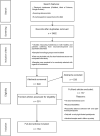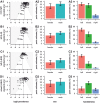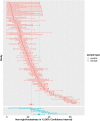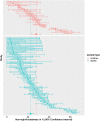Four meta-analyses across 164 studies on atypical footedness prevalence and its relation to handedness
- PMID: 32879356
- PMCID: PMC7468297
- DOI: 10.1038/s41598-020-71478-w
Four meta-analyses across 164 studies on atypical footedness prevalence and its relation to handedness
Abstract
Human lateral preferences, such as handedness and footedness, have interested researchers for decades due to their pronounced asymmetries at the population level. While there are good estimates on the prevalence of handedness in the population, there is no large-scale estimation on the prevalence of footedness. Furthermore, the relationship between footedness and handedness still remains elusive. Here, we conducted meta-analyses with four different classification systems for footedness on 145,135 individuals across 164 studies including new data from the ALSPAC cohort. The study aimed to determine a reliable point estimate of footedness, to study the association between footedness and handedness, and to investigate moderating factors influencing footedness. We showed that the prevalence of atypical footedness ranges between 12.10% using the most conservative criterion of left-footedness to 23.7% including all left- and mixed-footers as a single non-right category. As many as 60.1% of left-handers were left-footed whereas only 3.2% of right-handers were left-footed. Males were 4.1% more often non-right-footed compared to females. Individuals with psychiatric and neurodevelopmental disorders exhibited a higher prevalence of non-right-footedness. Furthermore, the presence of mixed-footedness was higher in children compared to adults and left-footedness was increased in athletes compared to the general population. Finally, we showed that footedness is only marginally influenced by cultural and social factors, which play a crucial role in the determination of handedness. Overall, this study provides new and useful reference data for laterality research. Furthermore, the data suggest that footedness is a valuable phenotype for the study of lateral motor biases, its underlying genetics and neurodevelopment.
Conflict of interest statement
The authors declare no competing interests.
Figures






Similar articles
-
Handedness and footedness in Korean college students.Brain Cogn. 2000 Jun-Aug;43(1-3):268-74. Brain Cogn. 2000. PMID: 10857707
-
Deriving estimates of contralateral footedness from prevalence rates in samples of Brazilian and non-Brazilian right- and left-handers.Laterality. 2005 Jul;10(4):353-68. doi: 10.1080/13576500442000148. Laterality. 2005. PMID: 16020372
-
Patterns of handedness and footedness in switched and nonswitched Brazilian left-handers: cultural effects on the development of lateral preferences.Dev Neuropsychol. 2007;31(2):159-79. doi: 10.1080/87565640701190734. Dev Neuropsychol. 2007. PMID: 17488214
-
[Motor assymetry].Fortschr Neurol Psychiatr. 2000 Feb;68(2):70-9. doi: 10.1055/s-2000-11648. Fortschr Neurol Psychiatr. 2000. PMID: 10719660 Review. German.
-
Foot laterality during childhood: a review.Int J Neurosci. 1993 Oct;72(3-4):175-82. doi: 10.3109/00207459309024106. Int J Neurosci. 1993. PMID: 8138373 Review.
Cited by
-
Broadening the scope: Increasing phenotype diversity in laterality research.Front Behav Neurosci. 2022 Oct 28;16:1048388. doi: 10.3389/fnbeh.2022.1048388. eCollection 2022. Front Behav Neurosci. 2022. PMID: 36386787 Free PMC article. No abstract available.
-
Tibiofemoral knee osteoarthritis progresses symmetrically by knee compartment in the GOGO cohort.Osteoarthr Cartil Open. 2022 Sep;4(3):100288. doi: 10.1016/j.ocarto.2022.100288. Epub 2022 Jun 18. Osteoarthr Cartil Open. 2022. PMID: 36081777 Free PMC article.
-
Human Lateralization, Maternal Effects and Neurodevelopmental Disorders.Front Behav Neurosci. 2021 Mar 22;15:668520. doi: 10.3389/fnbeh.2021.668520. eCollection 2021. Front Behav Neurosci. 2021. PMID: 33828467 Free PMC article.
-
Leftward asymmetry of the planum temporale and its association with language.Brain Struct Funct. 2025 Jul 4;230(6):112. doi: 10.1007/s00429-025-02980-y. Brain Struct Funct. 2025. PMID: 40613889 Free PMC article. Review.
-
International Survey Exploring Rider-Perceived Sidedness of the Horse.Animals (Basel). 2025 Jul 2;15(13):1956. doi: 10.3390/ani15131956. Animals (Basel). 2025. PMID: 40646855 Free PMC article.
References
-
- Ocklenburg S, Isparta S, Peterburs J, Papadatou-Pastou M. Paw preferences in cats and dogs: meta-analysis. Laterality. 2019;24:647–677. - PubMed
-
- Ocklenburg S, Güntürkün O. The Lateralized Brain: The Neuroscience and Evolution of Hemispheric Asymmetries. Berlin: Academic Press; 2017.
-
- Vallortigara G, Rogers LJ. Survival with an asymmetrical brain: advantages and disadvantages of cerebral lateralization. Behav. Brain Sci. 2005;28:575–589. - PubMed
-
- Bourne VJ. Examining the relationship between degree of handedness and degree of cerebral lateralization for processing facial emotion. Neuropsychology. 2008;22:350–356. - PubMed
-
- Bryden MP, Free T, Gagné S, Groff P. Handedness effects in the detection of dichotically-presented words and emotions. Cortex. 1991;27:229–235. - PubMed
Publication types
MeSH terms
Grants and funding
LinkOut - more resources
Full Text Sources
Medical
Research Materials

